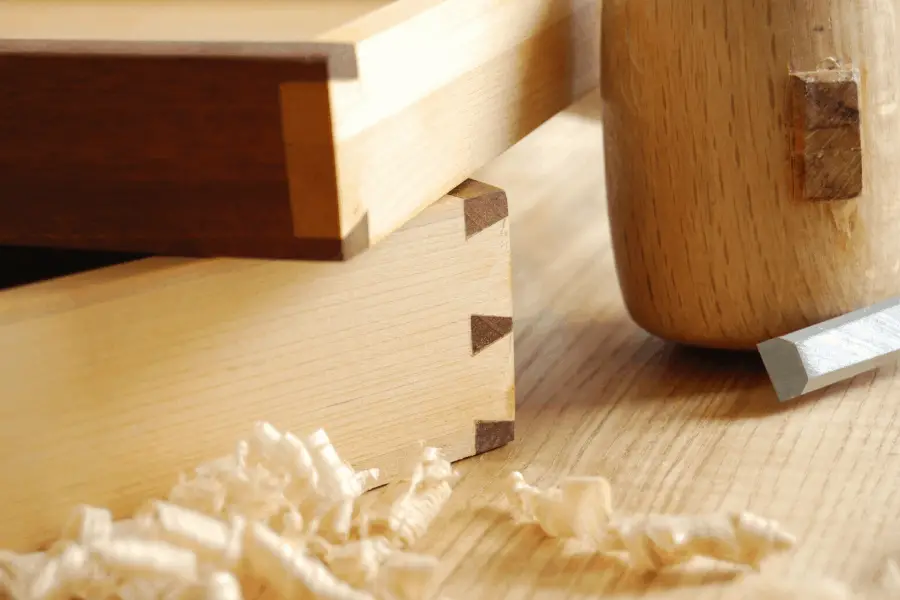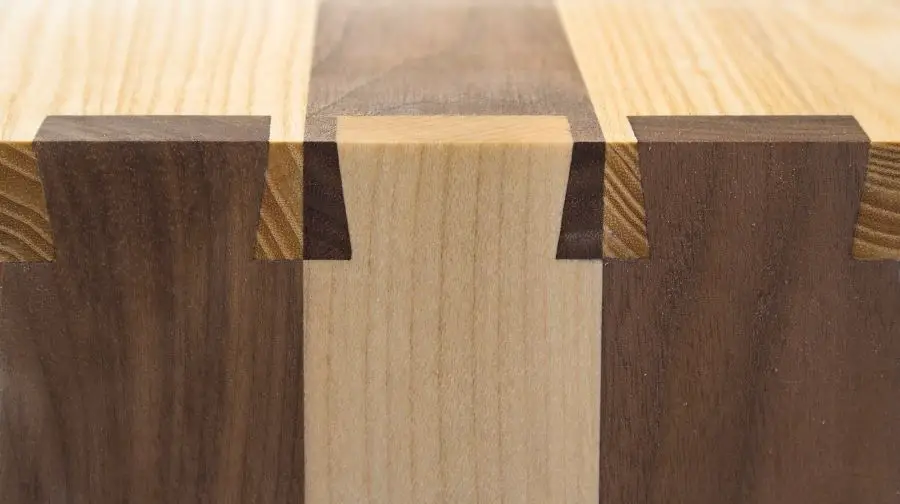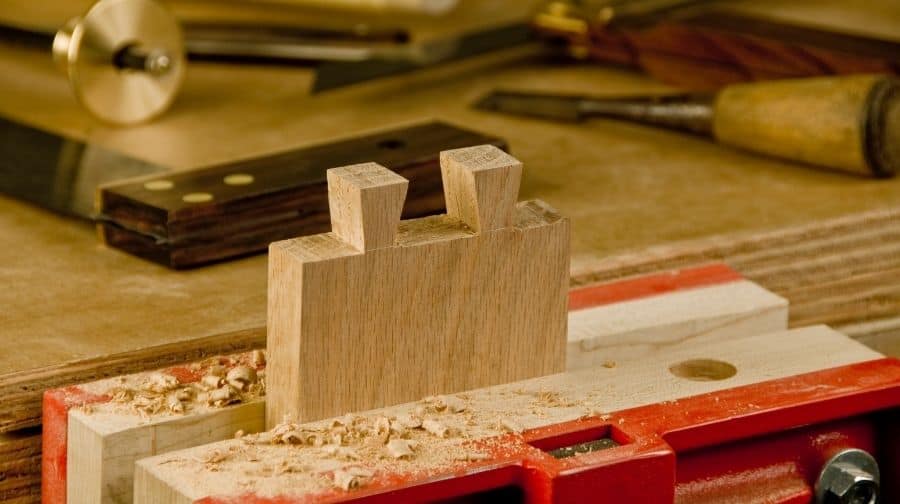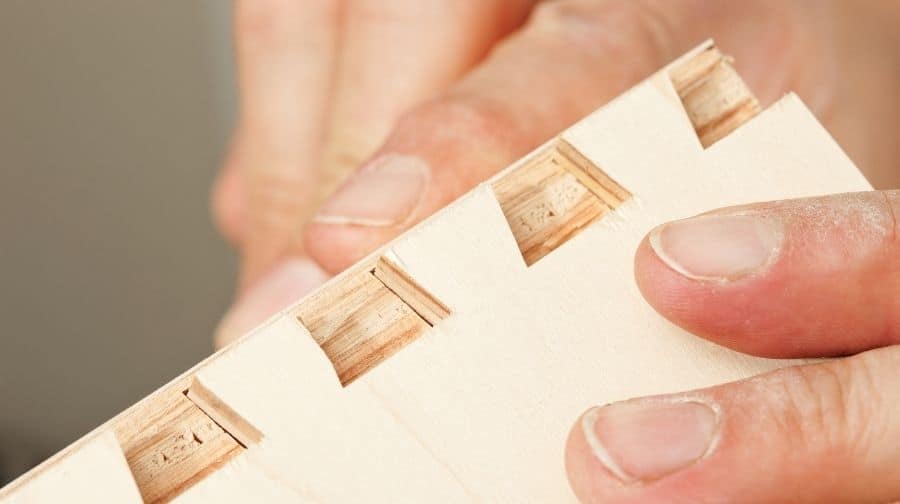
A dovetail joint is a beautiful and strong joint used to bond pieces of wood together at a 90-degree angle. There are so many varieties of wood joints you can use. Each style has a specific purpose and function that separates it from the others.
It can be confusing for a beginner to understand what all of the woodworking joints do so I researched through the internet and put together a quick summary on what dovetail joints are used for.
What is a dovetail joint used for? Dovetail joints join pieces of wood at a 90-degree angle and are used for making drawers, boxes, tables, trays, pencil boxes, benches, furniture, cabinets, timber framing and anything needing to combine two pieces of wood at a 90-degree angle.
Keep reading below to get a more in-depth look at dovetail joints and what they are used for.
What Is A Dovetail Joint Used For?
A dovetail joint is a method of joining two pieces of wood together that are typically used for creating furniture, cabinets, and timber framing. This method of jointing is known for having a hefty amount of tensile strength and an attractive appearance.
In this piece we will cover different types of dovetail joints, how to make a dovetail joint, some advantages and disadvantages that dovetail joints hold, and why they are referred to as dovetail joints.
Unique Types of Dovetail Joints
There are a few unique types of dovetail joints that can join two different pieces of wood together at a 90-degree angle. So let’s talk about the unique types, and the characteristics that make them different.
- Through Dovetail Joint
- Half-Blind Dovetail Joint
- Mitered Dovetail Joint
- Double Lapped Dovetail Joint
- Sliding Dovetail Joint
What Is A Through Dovetail Joint?
A through dovetail is a basic way to create a dovetail joint. They join two pieces of wood with a finger-like interlocking joint. This point where the pieces of wood interlock can be seen on the outside surfaces. Woodworkers can use the through dovetail joint method for creating bed frame corners, cabinets, and other common items.

What Is A Half-Blind Dovetail joint?
A half-blind dovetail joint allows the woodworker to hide the joint from one of the outer surfaces. Woodworkers hide the tails on one piece of wood inside the end of that piece of wood, making it only visible from one side. They are often used as a jointing method when attaching pieces of wood for a drawer together.
What Is A Secret Mitered Dovetail Joint?
The secret mitered dovetail completely hides the joint on all outside surfaces. It is only used on high-class upscale wood work. You can typically find it used in expensive cabinet builds. Even though it has a better aesthetic compared to the half-blind and through dovetail, it does not compromise on strength.
What Is A Secret Double-Lapped Dovetail Joint?
The secret double-lapped dovetail joint is very similar to the secret mitered dovetail joint. Both of them cannot be seen from any of the outside surfaces. The primary difference between this and the secret mitered dovetail is that there is a thin layer of grain on one end of the joint.

What Is A Sliding Dovetail Joint?
Woodworkers use the sliding dovetail joint when the intersection for the joint occurs in the middle of one board rather than on the edge. It still provides the same interlocking strength that other dovetail joints provide. The assembly of a sliding dovetail joint is easy, as all you have to do is slide the tail into the associated socket.
How To Make Dovetail Joints With A Router.
You can use a router to cut a dovetail joint when you use it with a jig. Picking up a pair of digital calipers will also make fine-tuning a lot easier when cutting your dovetail. Once you set up your jig on your router cutting out dovetail joints can be done rather quickly.
Simply attach a guide to the bottom of your router, and move in and out of the metal guides when you are cutting. Start by cutting details, and then when you are finished flip your piece of wood over and cut the sockets. The types of dovetail joints that you can create depend on the jig you purchase to use with your router.
You can also cut out dovetail joints with a handheld router. The benefit of using a handheld router is that you can get a more handmade look to your dovetails. You would start by either making a homemade jig out of wood pieces you have available or purchasing one.
After this, you can carefully mark the lines of your dovetails using a pencil. Carefully cut the material within those lines to create your dovetails. If you are someone who doesn’t like to cut right up to a line with a handheld router, you can leave a slight amount of room to chisel at the end.
To cut the tails afterward, you can use a bandsaw or a scroll saw. Again, mark the tails with a pencil and cut them out using the saw you have available. It is best to leave a tiny amount of wood outside of your lines so you can test the fit of the joint. If it is too tight, you can work on chiseling the tails until your joint fits properly.
Subscribe to Paul Sellers on Youtube
What Are The Advantages And Disadvantages Of A Dovetail Joint?
Before you start using a dovetail joint for any of your woodworking projects, it is worth considering the advantages and disadvantages that the joint offers.
Advantages Of A Dovetail Joint
The major advantage of using a dovetail joint is the strength of the bond they provide. This strength will make anything that you produce with dovetail joints resistant to wear and tear.
Dovetail joints are visually appealing, and they do not require any screws, textures, or fasteners. Not to mention there are different dovetail joint options which alter the visibility of the joint in the ultimate product, giving you more flexibility in terms of design.
Last, a dovetail joint will hold together exceptionally well without the use of glue. Although, if you do decide to use glue, this joint provides you with a sizable surface area for gluing.
Disadvantages Of A Dovetail Joint
One of the major disadvantages of a dovetail joint is that they are difficult to craft. For this reason it might be beneficial for people new to woodworking to stay away from dovetail joints or work on practicing them a lot before trying to use them for a project.
When creating a dovetail joint, there is little room for error. When you are cutting the joint, if there are any gaps or miss measurements, the joint will lose some of its strength.

Why Is It Called A Dovetail Joint?
The name dovetail was coined because of the appearance of the joint. The triangle shapes somewhat resemble the shape of a bird’s tail. In Europe, people also refer to the dovetail joint as a swallowtail joint, a culvertail joint, and a fantail joint.
Woodworking Joke:
Roger had worked hard at the shop all day, getting a kitchen job out the door. He was tired and grumpy when he got home. But when he quietly opened his bedroom door, he saw four legs where there should have been two.
In a rage, he grabbed a baseball bat and pounded on the blankets, he stumbled down the hall to the kitchen to call the police.
His wife was standing at the sink.
“Hi Honey,” she smiled. “I hope you don’t mind, but your folks came for the weekend so I gave them our bedroom.”
